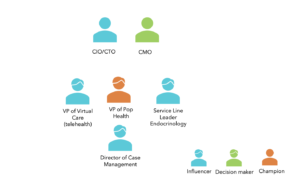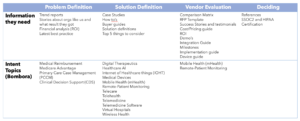In this post, we will help you create a detailed buyer journey that you can use in your sales and marketing planning.
The buyer journey helps you define and understand how the individuals at your target accounts buy solutions like yours. This will frame how you develop your plan to identify in-market accounts, engage individual buyers and convert them into customers. If they are already customers, it will help you frame how to grow your business with them.
In this process, you will start by defining the buyer collective, the individual roles within a target account, who are involved in buying decisions, and develop personas for the key individuals. For each persona, you will map out their issues as they go through a buying process, what information they need, what they will search for online, and what sources of information they trust.
The Buyer Collective
There are many individuals involved in complex sales. According to the Conference Executive Board (now part of Gartner), the average number of people involved in a buying process is 5.4. In some markets where consensus-driven decision-making is even more of a factor, the number may be much bigger.
Here is a typical buyer collective:

In simple terms, there are three types of stakeholders:
- Champions – They may often initiate the buying process, own the problem that the buyer collective is trying to solve, and will take the lead in the process. They are the most important stakeholder.
- Decision-makers – The second-most important stakeholder is the decision-maker. This person is usually the budget holder and may also be the champion’s boss or at least a senior executive who is responsible for the outcomes of the decision.
- Influencers – There are many of these, and they are typically involved throughout the process. They provide opinions and requirements and can sway which way the champion leads the process.
You will need to define the buyer collective for each of your ICPs. This could mean you have 2-3 buyer collectives, each with champions, decision-makers, and influencers.
Once you have defined the buyer collective, the next step is to create personas for members of the multiple buyer collectives.
One issue that often comes up is how many personas to create. If you have two ICPs and each has five members of their respective buyer collective, you could create ten personas. In our view, this is unmanageable. We believe you should limit yourself to four personas, at least at first. This would include all the champions and possibly one or two key influencers.
The Buyer Journey Process
There has been some debate of the value of personas. Frankly, it’s a good question. In our view, there is little point in creating beautifully designed, highly researched personas that sit on the shelf. If they are not actively used in your sales and marketing activities, why bother?
We go through the hard work of creating personas because they are a useful way to define the buyer journey compellingly. To us, the buyer journey is the single most important activity in the process of defining your ABM/ABX strategy. It is the foundation for building an effective engagement plan.
There are 5 steps in the process of defining a buyer’s journey.
Step 1 – Creating The Buyer Persona: This is where you will create a persona that represents your buyer collective stakeholder.
Step 2 – Defining Their Issues and Questions: In this step, you will brainstorm a list of questions and issues they have as they go through their buying process.
Step 3 – Determining What Information They Need: Here, you will list the types of information and content they found useful at each step of the journey.
Step 4 – Identifying What They Search For: As the buyer will be actively searching for information throughout the buying process, here you will develop an initial list of search terms and intent topics that you believe the buyer will use.
Step 5 – Defining Their Trusted Sources of Information: Lastly, you will create a list of content and information sources that the buyer will go for ideas, insight, and inspiration.
We believe that this process should be collaborative and can be best executed as a workshop that includes subject matter experts from your organization who have real experience and insight about the buyers. It should include sales, marketing, and customer representatives.
If you can afford the time and investment, these should be informed by customer insight interviews.
Step 1 – Creating The Buyer Persona
Your aim here is to create as real and credible a persona as possible. You are trying to create an artifact that will be used to train people to understand the buyer. It can also be used to gain alignment when discussing issues related to target audiences.
Here is an example of a persona:

As you can see, this includes:
- Name
- Title
- Where she works
- What are her responsibilities are
- What is her role in the buying process
- How she describes herself and other characteristics
The latter point is based on customer insight gleaned from the collective expertise of the team and possibly customer research.
We also find that it helps to find a real buyer on LinkedIn and use their information to populate the framework.
Step 2 – Defining Their Issues and Questions
Now we get into the most important step in this process, defining what’s important to them and what they need to get answers to as they go through their buying process.
We break this into four stages that the buyer collective goes through:
- Problem Definition – Where the buyer collective is trying to frame the problem they are trying to solve as specifically as possible.
- Solution Definition – Once they have agreed on what problem they are solving, the buyer collective will then evaluate different types of solutions. They need a lot of help here.
- Vendor Evaluation – This will be where they compare and contrast different options that address the solution they seek to implement.
- Decision-making – Lastly, the buyer collective must align and decide which vendor to appoint.
Note: Traditionally, the steps used in this process are Awareness>Consideration>Interest>Decision. We prefer to use our proposed approach as this focuses the attention on how the persona buys rather than how you want to move them through your funnel.
In this step, you will brainstorm the questions and issues you think the persona is trying to get answers to. Again base this on the best facts you have but try to be disciplined about what the buyer is looking for answers to rather than what you hope they are looking for.
Here is an example of the output of this exercise for the persona defined in Step 1.

Step 3 – Determining What Information They Need
The next step is to brainstorm the different types of information they need. This will be especially helpful when you get to the next phase and start engagement planning.
If you put yourself in the shoes of the champion, think about the type of information that will be helpful to them as they work with the rest of the buyer collective. Think beyond the content that you can create. While they might find that useful, they will be looking for information outside of your domain. This could include:
- Market Research
- Analysts Reports
- Articles by key opinion leaders
- Conference presentations
- The opinions of people in their network
- Buying guides
- RFP frameworks
- Customer reviews
- Implementation guides
Step 4 – Identifying What They Search For
Don’t forget that for most of the buyer journey, the champion and influencers will not be on your website or speaking with your salespeople. They will search and browse the Internet for information that will help them long before they engage with you.
Two key questions to answer in creating the buyer journey:
- What search terms and key phrases will they use as they research?
- What intent topics are available and relevant to the buyer journey you are working on?
We won’t spend a lot of time on the first question. We covered this is a prior post. The key thing is when you are creating your search strategy, you build it around the personas.
On the second topic, we expanded on Intent Data in a previous post. The vendors of third-party data can provide you with the topics they cover. As you can see in this example, we have captured what we believe to be the most relevant topics for the Population Health persona if they are researching patient engagement solutions. We have also included information they will need throughout the process:

Step 5 – Defining Their Trusted Sources of Information
The last step will also be very helpful as you plan how to engage the buyers. This is to define what sources they trust as they search for information to help them in their quest to find the best solution.
As you can see in this example for the Population Health persona, this includes people (peers, analysts, opinion leaders), trade shows, conferences, and various types of publications:

Once you have conducted the workshop to create the persona, you should document this as a shareable asset. Use it as a training tool for sales, marketing, and customer success.
We suggest that you re-evaluate these at least annually. What have you learned? What new insights have been gathered? What new additions to the team have perspectives? All of this can help you refine these personas as part of your planning process.
In a future post, we will explain how to use these buyer journeys to create an engagement and content plan.
Photo by Patrick Tomasso on Unsplash
Originally posted on LinkedIn.
